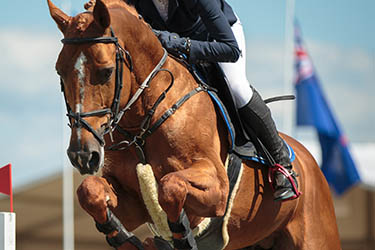Sport horses and equestrian events

History of equestrian sporting events in the Olympic Games
Equestrian events were commonplace in the Olympic Games of ancient Greece, yet they were not included in the modern Olympic revival until the 1900 Paris games. Prizes included artwork or cash prizes ranging from 4,000 to 6,000 francs. Perhaps the most notable news of that year was not the inclusion of equestrian competition, but the events themselves, which consisted of mail coach, hacks and hunters combined, jumping, high jump and long jump.
Seventeen competitors participated in the long jump competition, beginning with a 4.50-meter challenge. The winning leap, made by Belgium army officer Constant van Langendonck riding the mare Extra Dry, measured 6.10 meters. Much like the ill-fated long jump, the high jump competition also only fared one year of Olympic competition. Eighteen riders participated, with France's Dominique Gardères (on Canella) and Italy's Giovanni Giorgio Trissino (on Oreste), clearing 1.85 meters to share gold medal honors.
While equine long jump and high jump may have been relegated to the history books, it wasn’t until 1912 that equestrian events became a staple of the summer Olympics. Women weren’t allowed to participate in these events until 1951! Today, Olympic equestrian events are the only sport where men and women compete together.
What is a sport horse?
Sport horses are identified as a single or combination of breeds bred for traditional Olympic equestrian and competitive events other than racing. Sport horses, also called performance horses, are bred for traits in conformation, movement and temperament suited to specific disciplines.
Some types of sport horses include:
- British Warmblood
- Bavarian Warmblood
- Danish Warmblood
- Dutch Warmblood
- Hanoverian
- Holsteiner
- Irish Hunter
- Oldenburg
- Swedish Warmblood
- Trakehner
- Westphalian
According to Dressage Today, “…warmblood infers horses descended from the deliberate breeding of the European riding horse.” A more widely accepted definition for a “warmblood” today includes a horse with a minimum of four generations of documented sport horse bloodlines (inspected and registered by a recognized breeding association) bred with intent to excel in dressage, eventing and show jumping.
Warmblood sport horses are traditionally defined and registered by geographical area of birth, becoming regional “breed populations” with athletic, temperament and health traits well suited for that particular region.
Today, sport and performance horse registries such as the American Warmblood Society & Sporthorse Registry, the North American Sport Horse Registry and the Performance Horse Registry, as well as numerous European agencies, serve to identify, document and collect performance records for horses specifically bred for equestrian sports such as dressage, show jumping, eventing and driving.
Conformation for various disciplines
Conformation considers a variety of physical attributes, including:
- Shape of croup and angles of the hind limbs
- Shape and length of back
- Attachment of neck to shoulder and direction it comes out of the shoulder
- Length and angle of shoulder
Shape and length of neck
-
Width of jaw
While a horse with good conformation can compete reasonably well in any ring, certain traits have become desirable in each discipline. Jumpers require strong, correct legs and hocks to power over jumps and absorb shock on each landing. They should stay light on the forehand for speed and agility, and they must be able to tightly fold the front legs and raise the knees to clear the jumps. A longer neck helps a jumper balance himself over fences.
For maximum movement and extension, dressage horses require long shoulders and an uphill build, which means the withers measure higher than the croup. A shorter, strong back, long withers and a long, arched neck are beneficial traits in a dressage horse for collected gait and proper carriage. Horses in other disciplines excel with different sets of characteristics.
Reiners need strong hocks and stifles to withstand sliding stops and spins. Roping horses need strong hindquarters for bursts of speed, but also must have the agility and power to catch and hold a steer. Cutting horses tend to be smaller (14-15 hands), but are agile enough to outmaneuver cattle. Like most stock horses, they need the leg structure to endure fast starts, stops and turns.
Endurance horses, typically Arabians, are lean muscled with the heart and lung capacity to withstand distances of 50-100 miles per day. Strong, straight legs prevent extra stress on the joints over a variety of rough terrain. All disciplines require strong, healthy feet and well-balanced proportions.
Horses with less-than-perfect conformation may be able to compete successfully in a discipline for some time, but are likely to experience shorter careers due to lameness or injury. Many horses with conformation flaws make great mounts for those looking to ride for pleasure or compete at low levels. A pre-purchase exam (PPE) will reveal any conformation challenges that may limit a horse’s ability to perform well in certain disciplines.
The importance of conformation in each discipline can make a huge difference in the performance and welfare of your horse.
Covetrus is a proud sponsor of the 2018 FEI World Equestrian Games™ held in Mill Spring, North Carolina, from September 11-23 at the Tryon International Equestrian Center.
Contact your Covetrus representative for more information at 855.724.3461 or online.
Sources:
https://www.olympic.org/news/strange-but-true-long-and-high-jump-at-paris-1900-on-horseback
https://www.pets4homes.co.uk/pet-advice/breeds-of-sport-horses.html
https://dressagetoday.com/lifestyle/a-study-of-sport-horse-breeding
http://www.northamericansporthorseregistry.com/
https://www.usef.org/horse-services/performance-horse-registry
https://www.horsemagazine.com/thm/2017/08/conformation-and-its-implications-for-dressage-training/


Working Here
Our team members are encouraged to be the best they can be... at Covetrus we believe we impact one another.
Learn MoreNews & Events
FDA Cautions Pet Owners Not to Feed Texas Tripe Inc. Raw Pet Food Due to Salmonella, Listeria Monocytogenes
The U.S. Food and Drug Administration is cautioning pet owners not to feed their pets any of the Texas Tripe brand raw frozen pet food listed below because several samples of Texas Tripe raw pet food have tested positive for Salmonella and/or L. mono.
Careers
Are you looking for a place to let your talents shine? At Covetrus, we help our practitioner customers better serve their patients and take pride in providing the best customer experience possible. Search our open positions to see our available opportunities.
Newsletter
Stay current with what’s going on with Covetrus, subscribe to receive our newsletter and email communications. Subscribers will receive the latest information in practice management, sales and marketing, animal health, and more.



-3-(1).png?sfvrsn=2d806d73_0)

Leave a comment